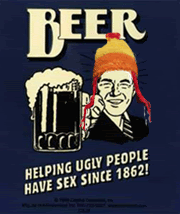JMUBrew wrote:Of course I work! Just have today and the next day off! (switching jobs/companies...start fresh on monday).


Speyedr wrote:Here is the Water Profile I plan to use for this:
Ca 109
SO4 122
Mg 18
Na 32
Cl 44
HCO3 149
This is from Brewater 3.0, and the Na and Cl are just from my water, no additions. Anyone see any problems with this? I upped the Sulphates to enhance the hops, but I don't want it too bitter.
Let me know if you have any suggestions.
Thanks,
Rob

OK, Time to put this thread to beddy byes.
21A-IPA
Batch size: 12bbls
pre-boil wort amount: 450 gallons
end of boil amount: 410 gallons
Malt:
Rahr 2-row Pale Malt 82%
Crisp Munich Malt 12%
Crisp Caramalt 6%
Hops: (all T-45 hop pellets)
Bittering: Warrior (added at beginning of boil)
Flavor: Centennial (added at 70 minutes into boil)
Whirlpool: Cascade/Tomahawk (added at end of boil) I use 2lbs of each hop in 410 gallons of wort at the end of of boil.
Dry Hops: for my batch size I use the following hops and amounts. Cascade 5lbs ( 45%), Amarillo 2lbs (18%), Styrian Goldings 2lbs (18%), Simcoe 2lbs (18%)
75 IBUs
Water Treatment:
The water in San Francisco is some of the best brewing water and is relatively soft. I add Calcium Sulfate to help showcase the hops.
Yeast:
WLP001 aggressively pitched.
Filtration: DE Filter
OG: 17.2 degrees Plato
FG ~3.9 degrees Plato
ABV ~7.2%
Mash Temp: 159F
90 minute boil
Notes:
My philosophy on this IPA is that your first sensory experience with this beer after looking at it is the sense of smell. This is why the dry hopping is fairly aggressive, which sets you up for the taste sensation. For as aggressive as this beer is hopped it actually is not too bitter and this is partly achieved by the high mash temperature. I feel a good IPA is just not about bitterness, but about the supporting malt backbone. Some IPAs are all bitterness and rather two dimensional I really try and make a multi-dimensional beer. Dry hops are added at fermentation temperature (68F) when the beer is about 1/2 plato point before terminal gravity and it is then capped. The slight yeast activity aids in keeping the hops in suspension. Capping it avoids driving the hop volatiles off with the fermentation activity, thereby keeping the aroma in the beer. This beer is also filtered. Removing the yeast to me is important and gives the beer a clean and less astringent flavor.
One other thing on the dry hopping; This past summer i experimented with dry hopping at lower temperatures. I added the Cascade, Styrian Golding hops and Amarillo at fermentation temp (68F) and then after a 3-4 days lowered it to 50F and then added to the Simcoe. The idea behind this is to gain more of the vegative flavor of the hops, thereby mimicking whole flower dry hopping. I had mixed results.
Ideally this would be a three week beer from kettle to glass, but because of tank space utlilization, typically it ends up being a two week beer. Also, we allow this beer to sit for 4 to 5 days at 32F before filtering, which aids in clarification and greater yield in the bright tank.
I hope that is everything. PM if you have any questions.
ShaunO

Return to Favorite Beer Recipes & Styles
Users browsing this forum: No registered users